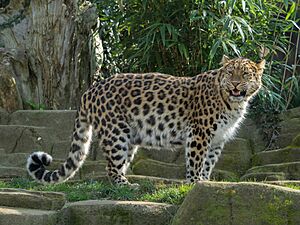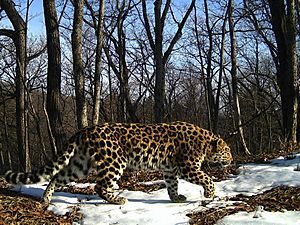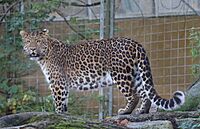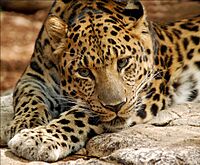Amur leopard facts for kids
Quick facts for kids Amur leopard |
|
|---|---|
 |
|
| A captive Amur leopard at the Colchester Zoo, England | |
| Conservation status | |
| Scientific classification |
|
| Kingdom: | Animalia |
| Phylum: | Chordata |
| Class: | Mammalia |
| Order: | Carnivora |
| Suborder: | Feliformia |
| Family: | Felidae |
| Subfamily: | Pantherinae |
| Genus: | Panthera |
| Species: | |
| Subspecies: |
P. p. orientalis
|
| Trinomial name | |
| Panthera pardus orientalis (Schlegel, 1857)
|
|
 |
|
| Historic and present distribution of the subspecies (excluding northern China to the west of Manchuria) | |
| Synonyms | |
|
|
The Amur leopard (scientific name: Panthera pardus orientalis) is a special type of leopard found in the Primorye region of southeastern Russia and northern China. It's one of the rarest big cats on Earth!
This leopard is listed as Critically Endangered on the IUCN Red List. This means it's facing an extremely high risk of disappearing forever in the wild. Back in 2007, experts thought there were only about 19–26 Amur leopards left in the wild in Russia and China.
As of 2015[update], the number was still very low, with fewer than 60 individuals estimated in Russia and China. But good news! Camera surveys between 2014 and 2015 found 92 leopards living in a huge 8,398 km2 (3,242 sq mi) area that crosses the border between Russia and China. As of 2023[update], the population had grown to an estimated 128–130 young and adult leopards.
Scientists have used genetic research to study Amur leopards. Their findings show that Amur leopards are very closely related to leopards in northern China and Korea. This suggests that the leopard population in this whole region might have become separated into smaller groups in the early 1900s. A leopard type once thought to be a separate subspecies, the North Chinese leopard (P. p. japonensis), was actually grouped with the Amur leopard in 2017. However, some recent studies in 2024 suggest it might be a distinct subspecies after all!
Contents
What's in a Name?
The names 'Amurland leopard' and 'Amur leopard' were first used by a scientist named Pocock in 1930. He was comparing different leopard skins at the Natural History Museum, London. He specifically called a leopard skin from the Amur Bay an 'Amur leopard'. Since then, this name has been used for these leopards in eastern Siberia and for those living in zoos around the world.
You might also hear the Amur leopard called the "Siberian leopard," "Far Eastern leopard," or "Korean leopard."
How Scientists Classified Amur Leopards
In 1857, a scientist named Hermann Schlegel first described a leopard skin from Korea and gave it the scientific name Felis orientalis. Over the years, other scientists and museum experts described different leopard specimens from the Russian Far East and China.
For example:
- In 1862, John Edward Gray described a tanned leopard skin as Leopardus japonensis.
- In 1867, Gray also described a leopard skull from near Peking as Leopardus chinensis.
- In 1903, J. Lewis Bonhote described a leopard skin from the Amur Bay as Felis villosa.
In 2017, a group of cat experts decided that P. p. japonensis (the North Chinese leopard) should be considered the same as P. p. orientalis (the Amur leopard). However, as mentioned, some newer research in 2024 suggests P. p. japonensis might be its own distinct subspecies.
What Genetic Research Tells Us
Phylogenetic analysis (which studies how species are related) of leopard samples from Primorsky Krai and North Korea shows that these leopards are very similar. This makes scientists think that the Amur leopard population became separated into smaller groups less than a hundred years ago. Even an old leopard skin from South Korea was found to be an Amur leopard through genetic testing.
Scientists have also studied the complete mitochondrial genome (a part of the leopard's DNA) from a wild male leopard in central China. This helps them understand the leopard's genetic makeup.
What Do Amur Leopards Look Like?
Amur leopards are easy to spot because of their unique fur, especially in winter. Their fur is thick and a pale cream color. The spots on their sides, called rosettes, are about 5 cm × 5 cm (2.0 in × 2.0 in) big and are spaced out, with thick, unbroken rings and darker centers.
Their fur is quite soft, with long, dense hair. In summer, the hair on their back is about 20–25 mm (0.79–0.98 in) long, but in winter, it can grow up to 70 mm (2.8 in)! Their winter coat can be light yellow, dense yellowish-red with a golden tint, or even rusty-reddish-yellow. In summer, their fur is brighter and more colorful.
Amur leopards are relatively small compared to other leopard subspecies. Males are larger than females.
- Males measure about 107–136 cm (42–54 in) long, with a tail that's 82–90 cm (32–35 in) long.
- They stand about 64–78 cm (25–31 in) tall at the shoulder.
- Males weigh between 32.2–48 kg (71–106 lb).
- Females weigh between 25–42.5 kg (55–94 lb).
The North Chinese leopard, which is now considered part of the Amur leopard group, was first described from a single tanned skin. It was yellowish-brown on top and pale underneath, with large, roundish black spots on its back and limbs, and smaller black spots on its head.
Where Do Amur Leopards Live?
Today, in the Russian Far East, the Amur leopard lives in an area of about 7,000 km2 (2,700 sq mi). They are very good at living in cold climates with heavy snow. They often live in mountainous areas, especially on rocky slopes that don't get much snow in winter. They tend to stay in places where wild sika deer (Cervus nippon) live, or where people raise deer.
These leopards can even cross between Russia, China, and possibly North Korea by crossing the Tumen River, even though there's a tall wire fence marking the border.
The first time an Amur leopard was caught on a camera trap in northeastern China was in 2010. This happened in the Hunchun National Nature Reserve, in the Changbai Mountains of Jilin and Heilongjiang Provinces. This area has broadleaved and conifer forests at elevations of 600–1,200 m (2,000–3,900 ft), where the average temperature is about 1.5 °C (34.7 °F). Leopards have been photographed many times in this area by camera traps.
In other parts of China, Amur leopards live in smaller, separate groups, mostly in protected areas. For example, in Shanxi Province, leopards were recorded in 16 protected areas during camera surveys between 2007 and 2014.
Amur Leopard's Historical Home
Fossils of leopards from the Pleistocene era have been found in Japan, but it's not certain if they were Amur leopards.
Historically, Amur leopards lived across eastern Siberia, northeastern China (including near Beijing and its northwest mountains), Manchuria, and the Korean Peninsula. Amur leopards even entered the city of Seoul in the late 1800s! Sadly, they were hunted a lot in Korea for their skins, especially during Japanese rule. At least 624 leopards were killed between 1910 and 1945. In South Korea, the last known leopard was captured in 1970. Now, the Amur leopard is considered to be completely gone from South Korea, and probably from North Korea too. However, some researchers think that very remote parts of North Korea might still have good leopard habitat.
In Russia, the Amur leopard's natural home shrunk a lot during the 1970s, becoming only about 20% of its original size. In the 1950s, leopards were seen about 50 km (31 mi) north of Vladivostok city.
In China, Amur leopards used to live in the Lesser Khingan, Changbai, and Wanda Mountains until the 1970s. In the following years, their range became much smaller, limited to a few areas in Jilin and Heilongjiang Provinces. Today, only small, isolated groups remain in northern China, mainly in Jilin.
How Do Amur Leopards Live?

Like other leopards, Amur leopards are usually solitary, meaning they live alone, unless a mother has cubs. Camera traps show that they are more active during the day (diurnal) than at night, and also active during dawn and dusk (crepuscular) in both summer and winter. This matches when their prey animals, like Siberian roe deer, Manchurian sika deer, and Ussuri wild boar, are most active.
Amur leopards are very particular about their territory. An individual's territory is usually in a river basin and extends to the natural borders of the area. The territories of two leopards might overlap a little, but not much. The size of a leopard's territory can vary from 5,000–30,000 ha (19–116 sq mi), depending on its sex, age, and whether it has a family. Leopards use the same hunting trails, travel routes, and even resting spots for many years.
Leopards live in places where there are plenty of wild animals to hunt. They follow herds of ungulates (hoofed animals). In the Ussuri region, their main prey includes Siberian roe deer, Manchurian sika deer, Manchurian wapiti, Siberian musk deer, Amur elk, and Ussuri wild boar. They also hunt hares, Asian badgers, fowl, and mice. In Kedrovaya Pad Nature Reserve, roe deer are their main food year-round, but they also hunt young Asian black bear cubs under two years old.
When there aren't many hoofed animals, leopards will have larger home ranges, sometimes up to 100 km2 (39 sq mi).
In the early 1990s, scientists used radio collars to track Amur leopards. They saw a fight between two males at a deer farm, which suggests that Amur leopards like to hunt at these farms. Female leopards with cubs are often found near deer farms because the large number of domesticated deer provides a reliable food source, especially when food is scarce.
Raising Amur Leopard Cubs
Amur leopards can start having cubs when they are 2–3 years old and can continue to reproduce until they are 10–15 years old. The female's heat cycle (estrus) lasts 12–18 days, sometimes up to 25 days. Pregnancy (gestation) lasts 90–105 days, usually around 92 to 95 days.
A newborn cub weighs about 500–700 g (18–25 oz). They open their eyes around 7–10 days old and start to crawl on days 12–15. By their second month, they start coming out of their dens and begin to eat meat. Cubs are weaned (stop drinking milk) when they are three months old and then learn to hunt. They continue to nurse for five or six months.
Cubs become independent when they are about two to three years old. They usually stay with their mother until they are around 18 months to two years old. Sometimes, young leopards will stay with their mother until she is ready to have cubs again. In the past, cubs were most often seen in Kedrovaya Pad Nature Reserve and northeastern China between late March and May. Litters usually had two to three cubs. In zoos, some Amur leopards have lived for 21 years!
In 2011, a female Amur leopard was tracked with a radio collar in Russia. For three years, she used a home range of 161.7 km2 (62.4 sq mi). When she had cubs in late June, she stayed in a small area of about 3 km2 (1.2 sq mi) for a month, moving her cubs three times. As autumn came, she slowly increased her home range. Once the cubs were over a year old, the family moved together in her original large home range.
In a 1997 leopard count, four females with young only had one cub each. Radio tracking studies confirmed that young leopards stay with their mother for two years.
Why Are Amur Leopards Endangered?
Amur leopards face many dangers, including poaching (illegal hunting) of both the leopards themselves and the animals they eat. They also suffer from habitat loss and deforestation (forest clearing). Their natural home is also threatened by forest fires and the building of new roads.
Because there are so few Amur leopards left in the wild, their gene pool (the total genetic information in the population) is very small. This means they have low genetic diversity, which puts them at risk from inbreeding depression. This is when animals that are too closely related breed, leading to weaker offspring with health problems.
In 2015, a wild Amur leopard was found with canine distemper virus in Russia. Because the population is so small, all wild leopards could be exposed to diseases from domestic animals or other wild animals in the future.
Amur leopards sometimes live in the same areas as Siberian tigers (Panthera tigris tigris). In the Changbai Mountains, leopards have been found at higher altitudes and further away from towns and roads than tigers. Tigers can kill leopards if there aren't enough large and medium-sized prey animals for both of them. Competition between these two predators might decrease in summer when there are more small prey animals available. In winter, conditions are harder for tigers, which might increase how much they compete with leopards for food.
Amur leopards also share their habitat with Ussuri brown bears (Ursus arctos lasiotus), but scientists haven't recorded any interactions between these two species.
The Threat of Poaching
Illegal hunting of Amur leopards is the biggest danger to their survival. In 1999, poached leopard skins were offered for $500–1,000 near a protected area in Russia.
Forest Fires and Habitat Loss
Human-caused fires are another major threat to Amur leopards. Farmers often set fire to fields for various reasons, such as making the soil better for livestock, killing ticks, making scrap metals easier to find, clearing vegetation along train tracks, and encouraging fern growth. Young ferns are sold in shops and exported to China as a popular dish.
Surveys using satellite images showed that, on average, 19% of southwest Primorye burns every year, and a total of 46% burned at least once in six years. Because of frequent fires, much of the land in southwest Primorye has changed from coniferous forests (which are good leopard habitat) to open "savannah" landscapes with grass, oak bushes, and isolated trees. Leopards seem to avoid these areas, probably because there aren't many hoofed animals there.
In the 20th century, large deer farms were built over thousands of hectares of leopard habitat. The velvet from deer antlers was sold to Asian pharmacies. However, the number of deer farms has gone down a lot since the late 1990s.
Development Projects
Several plans for economic activities in southwest Primorye have posed a serious threat to the Amur leopard. A plan to build an oil pipeline from central Siberia through Primorye to the coast of the Sea of Japan was stopped. Another plan for an open pit coal mine in the heart of the Amur leopard's range was also not carried out, thanks to pressure from environmentalists and the Ministry of Natural Resources.
The location of southwest Primorye (being close to major cities, the Sea of Japan, and the borders with North Korea and China) makes it attractive for economic activities like transport, industries, tourism, and building new infrastructure. While logging itself isn't the biggest threat, the roads built for transporting logs increase human activity and pressure in unprotected leopard habitats.
The Problem of Inbreeding
A serious problem for the Amur leopard is potential inbreeding. The small remaining population could disappear due to genetic problems, even without direct human impact. The levels of genetic diversity are very low, which suggests that the population has been inbreeding for several generations, or that it went through a population bottleneck (a sharp reduction in population size). Such low genetic diversity can lead to severe reproductive and birth defects that harm the health, survival, and ability to reproduce for some small populations.
Cub survival has also declined over time: from 1.9 cubs per female in 1973 to 1.7 in 1984, and 1.0 in 1991. Besides fewer cubs surviving naturally, there's a high chance of death for leopards of all ages due to diseases or direct human impact.
How Are We Protecting Amur Leopards?
The Amur leopard is listed in CITES Appendix I. This means it needs strong protection from illegal trade in its skins and bones.
In 2001, a meeting was held in Vladivostok to plan how to help the wild Amur leopard population recover and survive. Chinese participants announced they would create a new protected area in Jilin Province, the Hunchun Nature Reserve. Since 2014, Russian and Chinese biologists have been working together to monitor the Amur leopard population across the border.
The Amur Leopard and Tiger Alliance (ALTA) is a group of Russian and Western conservation organizations working to save the Amur leopard and tiger. ALTA believes that only by working together can these endangered animals be saved from extinction. ALTA works closely with local, regional, and government groups to protect the region's wildlife through conservation, sustainable development, and involving local communities. The Phoenix Fund and the Wildlife Conservation Society help carry out ALTA's projects in Russia and China.
For leopard conservation, ALTA aims to:
- Have a population of 35 adult female leopards (100 total leopards) in southwest Primorye and the Jilin-Heilongjiang border region.
- Create a second population of 20 adult female leopards (60 total adults) in areas where leopards used to live.
Conservation projects for the leopard include:
- Four teams with 15 members who work to stop poaching in the leopard's habitat.
- A special task force of local police and anti-poaching teams.
- Monitoring the leopard population by counting tracks in the snow and using camera traps.
- Monitoring and analyzing how fires affect leopard habitat and how well firefighting efforts work.
- Studying leopard habitat using geographic information system (GIS) techniques and satellite images to understand factors like habitat quality, land use, and human settlements.
- Developing land-use plans that consider the future needs of leopards.
- Supporting protected areas where leopards live.
- Paying farmers if leopards or tigers kill their livestock.
- A complete education program for school children and students in the leopard's range.
- Supporting hunting leases and a program to help hoofed animal populations recover.
- A media campaign to raise awareness about the leopard's struggles.
- Support and technical help for the new Hunchun Nature Reserve in China, which borders the leopard's habitat in Russia.
An oil pipeline that was planned to be built through leopard habitat was rerouted after conservationists campaigned against it.
Bringing Amur Leopards Back to the Wild
Since 1996, ALTA members have discussed the idea of bringing leopards back to the south of the Sikhote-Alin mountain range. In 2001, a plan was made to develop a second population of Amur leopards in the Russian Far East. For this to work, scientists needed to understand why leopards disappeared from the southern Sikhote-Alin in the mid-20th century. It was recommended to:
- Figure out why local populations died out.
- Get support from local people.
- Increase the number of prey animals in areas chosen for reintroduction.
- Make sure the chosen areas are suitable for reintroduction.
- Ensure the survival of the existing leopard population.
There are two ways to get leopards for reintroduction: leopards born and raised in zoos, and leopards raised in a special reintroduction center that go through a program to prepare them for life in the wild. For reintroduction to be successful, the breeding and release center must focus on helping the captive-born cats learn important behaviors. They need to learn how to hunt and kill natural prey, and how to avoid humans and tigers.
In March 2009, during a meeting with Vladimir Putin, Russia's Minister of Natural Resources confirmed that the ministry plans to reintroduce leopards and create suitable, safe habitat. He also stated that the government had already set aside all the necessary funds for the project.
Scientists have identified potential reintroduction sites (connected areas of good habitat) in the southern Sikhote-Alin. Three potential coastal habitat areas could support about 72 adult leopards, which is more than the 50 individuals needed for a self-sustaining population.
Amur Leopards in Zoos
A program to breed Amur leopards in zoos was started in 1961, using nine leopards born in the wild. However, a genetic study found that at least two of the original captive leopards had genetic information that didn't match any wild Amur leopards. This means that some of the leopards in American and European zoos have genes from a different leopard subspecies. The European Endangered Species Programme has tried to minimize this contribution and maintain the genetic diversity of the captive population.
As of December 2011[update], 173 Amur leopards were living in zoos worldwide. The European program had 54 males, 40 females, and 7 unsexed individuals. In American and Canadian zoos, another 31 males and 41 females were part of their Population Management Program.
See also
 In Spanish: Leopardo del Amur para niños
In Spanish: Leopardo del Amur para niños
- Leopard subspecies
- Chinese leopard
- Zanzibar leopard







